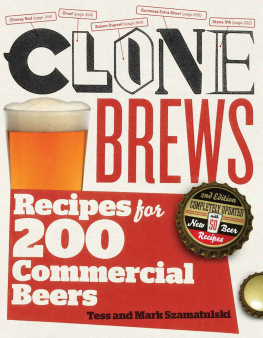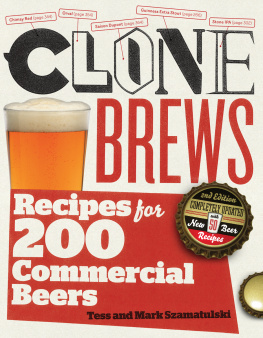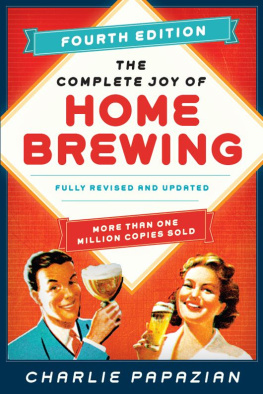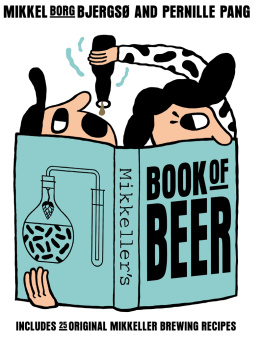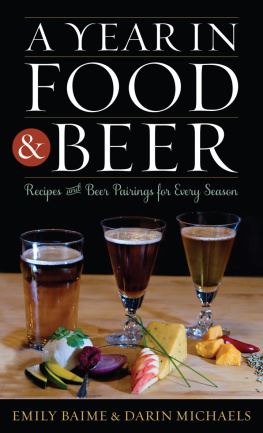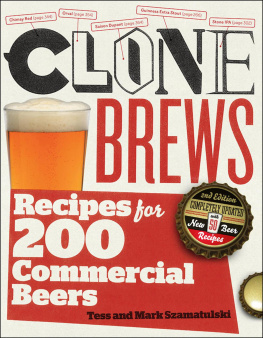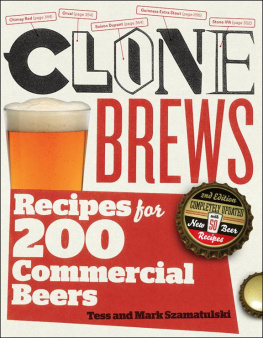Contents
Dedication
We dedicate this book to the memory of Tesss father, Arthur Paul Demcsak, Tesss mom, Bess Demcsak, and Marks dad, Stan Szamatulski. We have felt their love and support either with us on Earth or shining down on us through the many months and years we have spent researching and writing CloneBrews. We wish they could be with us to share a beer in celebration of the release of this second edition. If there is a heaven, then there has to be beer there. Please raise a pint with us to celebrate. Cheers!
Acknowledgments
We would like to acknowledge the following people and companies for helping us with this book. We are eternally grateful to all of them.
Many thanks to our family for all their support and encouragement: our children, Noella, Paulette , and Rob; our sons-in-law, Paul Duh and Eric Schmidt, who are both great brewers; our three incredible grandchildren, Aquinnah, Amelia, and little Paul; our mom, the late Bess Demcsak, who at the age of 79 realized she loved beer; Sharon and Michael Demcsak for all their love and support; and the Szamatulski family for all their enthusiasm.
To all our loyal customers and friends who have sampled beers with us, brewed our recipes, shared those brews with us, and brought us beers from all over the United States and the world: our manager, Burton Hansell, and Mike Sebas, Gary Chase, Tom Conti, Naheel and Jim Norton, Blake Brown, Mark Labell, Eric Condo, Jim Mitchell, Dominik Wellman, John and Mimi Mudrick, Gregg Glaser, Mike Novak, Lauren Mazurok, Tom Remilard, Mark Tambascio,Gino Gaucher, Diana Durden, Bill Breen, Joe Burton, Dude Nelson, Keats Gill, Doug Wilborne, Drew Rosenberg, W. Neville, Kate Chase, Charlie Versaci, Dave Fitch, Phil Clarke, Frankie Flynn, Barbara and Robert Rickman, Phil Simpson, and all the other homebrewers and friends from Maltose Express. Special thanks to Terry Boyd, of Mountview Wines in Naugatuck, Connecticut, for all the help in finding beers we needed to sample; Doug Hamm, former brewerat Elm City; Johnny Fincioen, of Global Beer Network, for sending samples of all his wonderfulBelgian beers; Jeff Browning, brewer at Br Rm; Yuengling Brewing Co.; Bill Fadeley, of Bulunda Import Export; Antonio Abraham, of Balearic Beverage Distributors; Yasuyuki Yas Shimauchi, of Sapporo; Drew Behr, of Magic Hat Brewing; Tomme Arthur, of Lost Abbey Brewing Co.; Mitch Steele, of Stone Brewing Co.; Anne Latchis, of Amazon; Wasfi Skaff, of American Fidelity Trading; Guinness Importing; the helpful people at Pilsner Urquell; Athene Importing; Dave Logsdon, of Wyeast Laboratories; the very helpful people at Merchant du Vin, for sending us samples and information; and the very knowledgeable people at Vanberg and DeWulf. Also thanks to Fireworks Brewery, of White Plains, New York, and Ed Cody and Ken Espenak, of Photographic Images. Thank you to all the people who have dropped off beer for us to sample, the beers from Portugal, Spain, Poland, England, Slovakia, and the Czech Republic. We were not there to thank you in person, so we hope you read this. There are many more customers and friends who have helped and supported us. We are sorry if we have left anyone out, but please accept our heartfelt thanks. We would also like to thank the late Michael Jackson for all his great books. They have been a wealth of information for us. Last of all we would like to thank our first editor, Pamela Lappies, for providing us the opportunity to write this book, and the editor of our second edition, Margaret Sutherland.We hope you enjoy our book as much as we have enjoyed writing it, and may Gambrinus, the legendary patron saint of beer, watch over you and your brews always.

PART 1
The Art of Cloning a Beer
You will have to forgo that warm wool sweater and some nice juicy lamb chops, but you get something even better gallons of fresh, delicious clonebrew! The best part of this whole process is that you can make your clonebrew just like the commercial brew, or you can adjust it to your own taste. For example, suppose you want to clone your favorite pale ale but lately have come to enjoy hoppier beers. The solution to your dilemma is to make a hoppier clone of your favorite commercial beer. Tweak the recipe to just the way you like it. Thats the beauty of homebrewing you are in charge.
We provide information in this section to help you clone your favorite beers. It does take practice. Some of the worlds great breweries have been brewing for hundreds of years. The more beers you sample, evaluate, and research, the more experienced you become. Tough work, cloning. Soon you will be able to identify hops, specialty malts, yeasts, and even spices. The more information you can acquire before you begin to clone, the more accurate you will be. Its best to concentrate on one style at a time. The art of cloning boils down to simply researching the beer and knowing your beer styles, hop varieties, grains, specialty ingredients, and yeasts. Remember that practice makes perfect. Drink up, and let the cloning begin!
Know Your Clone Subject
Research the beer before attempting to clone it. Most breweries have Web sites that provide statistics about their beer. You can also e-mail the breweries for additional information.
After we have completed our research we take the following steps when cloning a new beer: Pour the beer into a goblet to evaluate it. (Ideally, we also have at least three examples of the style we want to clone on hand for comparison.) Appraise the color of the head and then the color of the beer. Inhale deeply and explore the aroma. Do you smell hops, malt, spices, yeast? Now on to taste. How bitter is the beer? Do you taste hops, malt, spices, yeast? Finally, analyze the finish. Is it long and dry, short and hoppy? Put all of the information you have obtained from observing and sampling the beer with the facts you have gathered, and now you are well on your way to cloning. Brew the beer from the recipe you have formulated and then compare it to the original. If need be, tweak it and brew it again.
Books and Magazines
There is a greater wealth of information about beer now than ever before. Many magazines are devoted to homebrewing and beer appreciation, and hundreds of books have been written about the subject. Among the best sources of accurate information are the works of Michael Jackson, British author of many beer books. In many instances his books provides original gravity, color ratings, alcohol content, and types of grains and hops used in brewing a specific commercial beer. He even wrote a book devoted just to Belgian beers. His Pocket Guide to Beer is invaluable, especially if you travel and are sampling beers in another state or country.
Read Your Beer Bottle
You will find, especially with American microbrews, that there is valuable information printed on the labels. Look for alcohol content and mention of the types of malts and hops used. Determine if the beer is a lager or an ale. If the beer is imported, in what part of the country is the brewery located? This can help you to determine ingredients. For example, if you are sampling a lager from Bavaria, Germany, you will be considering a Bavarian lager yeast, regional Spalt or Tettnanger hops, and some German light crystal and Pilsner malt. You have applied your knowledge of hops, malt, yeast, and style of beer before even opening the bottle.

